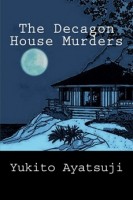 Author: Yukito Ayatsuji
Author: Yukito Ayatsuji
Translator: Ho-Ling Wong
U.S. publisher: Locked Room International
ISBN: 9781508503736
Released: June 2015
Original release: 1987
Originally published in 1987, Yukito Ayatsuji’s debut novel The Decagon House Murders is credited with sparking a renaissance in Japanese honkaku mystery fiction, a subgenre of classic detective fiction emphasizing logic and fair play. The novel was translated into English by Ho-Ling Wong (the text based off of the Japanese edition from 2007) and released in 2015 thanks to the efforts of Locked Room International, a group which works to publish translations of novels featuring locked room mysteries and impossible crimes. The English edition of The Decagon House Murders also includes an introduction written by Japanese mystery author Soji Shimada, which places the novel within the historical context of Japanese and world mystery fiction, as well as a brief essay by the translator. It was only after reading The Decagon House Murders that I realized why Ayatsuji’s name seemed so familiar to me—he wrote the horror mystery novel Another which was also recently translated and which received both a manga and an anime adaptation. Ayatsuji also happens to be the husband of Fuyumi Ono, the creator of The Twelve Kingdoms which I greatly enjoy.
Located on the currently uninhabited island of Tsunojima is the Decagon House, a peculiar building designed by the eccentric architect Seiji Nakamura, a man believed to have committed a series of murders on the island before taking his own life. The house, the island, and their history provides the perfect setting for some of the more accomplished members of a university mystery club to relax and find some inspiration for their writing during the break before classes resume. But what most of the group doesn’t realize is that Seiji Nakamura was the father of Chiori Nakamura, another club member who recently died as the result of one of their drinking parties. Chiori had a preexisting health condition, but at least one person feels that the club is responsible for her death. On the mainland members are receiving ominous and threatening letters signed with the name Seiji Nakamura and on the island one person after another dies under strange circumstances, and no one but the murderer knows killer’s identity.
The focus of The Decagon House Murders is definitely on its mystery. Character development in the novel is limited, enough to distinguish the individual players and to establish some of their back stories, but not so much that the reader really gets to know them as people. The murderer, whose motivations and meticulous schemes are eventually revealed, is the person who has the most depth as a character. Although there are twists to the story, Ayatsuji’s writing style is likewise straightforward and clean, lacking in heavy description or embellishments. Distraction is kept to a minimum as the facts of the case are laid out one after another, allowing readers the chance to pick up on clues and develop their own theories before everything is explained. At the same time, the members of the group trapped together on the island are themselves struggling to come up with their own solutions before they all end up dead. Ultimately, The Decagon House Murders is primarily about the murderous plot and it its execution.
Ayatsuji’s decision to make a large part of the cast of The Decagon House Murders members of a mystery club is a brilliant one. They are all well-versed in how similar crimes play out in fiction, but now they are faced with an increasingly deadly reality where those rules and expectations don’t necessarily apply; even though they know the possibilities, they can’t anticipate what will actually happen. I, too, am fairly familiar with many of the tropes and tricks used in mysteries about seemingly impossible crimes, however The Decagon House Murders still managed to surprise and satisfy me with its clever twists. I also particularly liked the narrative structure of the novel. At first the chapters alternate between the developing situation on the island and a related investigation occurring on the mainland, but eventually the two connected storylines merge together for the novel’s big reveal. The Decagon House Murders is apparently the first volume in a series of mysteries involving buildings designed by Seiji Nakamura. I have no idea if there are any plans to translate the others, but I would certainly be interested in reading them.

[…] particularly interesting!) The first review I posted was of the rather clever debut mystery novel The Decagon House Murders by Yukito Ayatsuji (who also happens to be the creator of the horror mystery Another and the […]